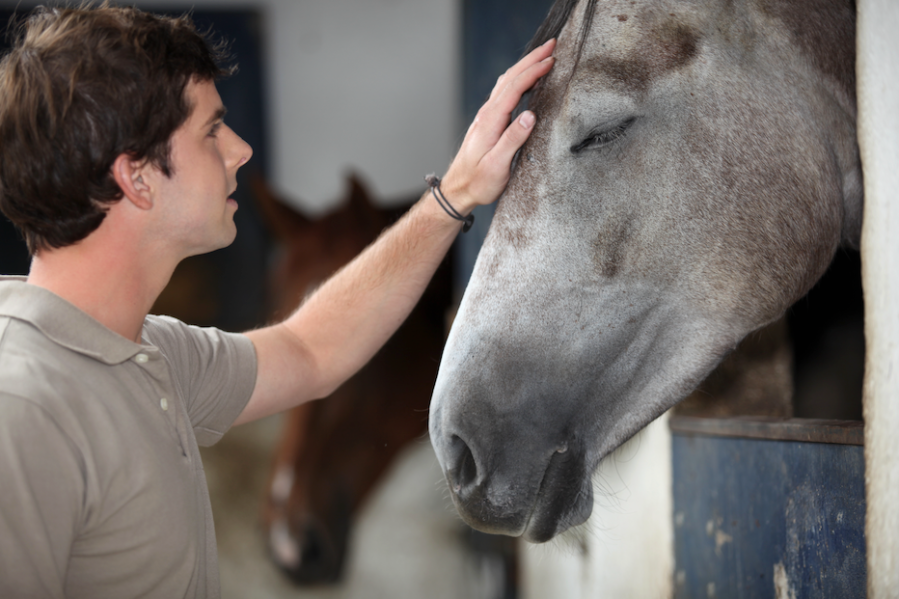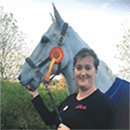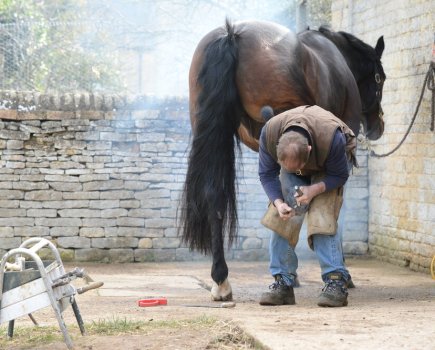There is plenty to think about when considering how to take care of a horse. A good starting point are the following seven core areas: hoof care, diet, exercise, general health, teeth, worm control, and mental wellbeing, all of which will be covered in this article.
Fail to provide what your horse requires in any of these areas, and you leave them at risk of serious illness, pain, physical problems, and general unhappiness.
In order to take care of a horse well, you’ll need time, money and commitment. Horses require care come rain or shine, all-year round, and during the good times and the not so good.
You won’t always get it right, but if you’re willing to learn (it never stops) you’ll find that horse ownership is one of the most rewarding journeys you’ve ever been on.
How to take care of a horse
I have been fortunate enough to own and take care of numerous horses and ponies in my lifetime. Every single one of them has required a slightly different care approach to satisfy their individual needs and personalities.
I’d say that this is the golden rule to remember about horse care: they’re all different.
Each of the seven core areas of horse care is influenced by things like changing seasons, where you live, the age and breed of your horse and pony, and how experienced you are as a horse owner and rider.
I talk more about each one below.
Essential hoof care for horses
Every domesticated horse in the world requires regular hoof care from someone who is qualified, and checks must be carried out at regular intervals throughout the year. This is the case whether a horse is shod (wears shoes) or unshod (barefoot).
In the UK, only a qualified farrier can put shoes on a horse; an equine podiatrist is able to do hoof trimming, but make sure you choose one with the correct credentials.
Breed, age and workload can significantly influence the quality of your horse’s hooves.
“It’s important to consider that what works for your horse might not work for another,” states farrier Jack Climo Dip WCF, who is based in Worcestershire.
“Work out the best hoof care routine for your horse and stick to it. Speak to your farrier if you have any concerns and keep on top of any issues as they arise.
“Bear in mind that hooves can grow more quickly in summer, so horses often benefit from a shorter shoeing cycle. Long toes and unbalanced feet will increase strain on the foot, which can cause cracking, bruising and lameness,” adds Jack.
Boosting hoof quality
Providing a balanced diet is key to understanding how to take care of a horse, not least because lacking in vitamins and minerals will leave horses vulnerable to poor quality hooves that become brittle and weak.
“If your horse is not receiving supplementary feeds, ensure they are having a balancer or vitamin and mineral supplement. For horses with poor quality hooves, feed a supplement with biotin to improve hoof quality,” advises Jack.
“Don’t forget it will take six to nine months to have any effect. This is how long it takes for new hoof to grow, so don’t give up if you don’t see results immediately.”
Your horse should be seen by a farrier at the same intervals all year round for regular shoeing and/or trimming. If you are planning to compete your horse, you might need to ask your farrier for stud holes in the spring.
General hoof care requirements change when the weather becomes milder too. Dry hooves crack and become brittle, for example, so consider a topical dressing to help balance the moisture content in the hoof.
Ask your farrier which they recommend, as they know your horse’s hooves the best. Changeable weather is really hard for hooves to cope with, and the constant change from wet to dry and wet again really impacts hoof health.
Related content:
- Essential hoof care guide
- Benefits of barefoot
- What is a farrier?
- All about hoof trimming for horses
Diet
For a horse to look healthy and be in good condition on the outside, they need to be healthy on the inside too. This means providing them with a healthy, balanced diet that provides all the nutrition they need.
It is also means ensuring they maintain a healthy weight. Equine obesity is a major welfare issue around the world, which triggers all sorts of distressing diseases, including laminitis and equine metabolic syndrome.
Just as a fat/overweight horse isn’t healthy, neither is an underweight horse. Monitoring any weight gain or loss on an ongoing basis is a key part of how to take care of a horse.
“Carrying too much weight is never a good thing for any horse,” says Dodson & Horrell nutritionist Charlotte Wilkinson. “Equine obesity brings with it an increased risk of health conditions, such as laminitis, orthopaedic diseases, or infertility. It also means general poor health and performance.”
A good horse diet is one that is forage based (that is, mostly hay/haylage and grass), topped up with hard feed and relevant supplements as required.
The key is having a feeding plan that provides enough energy (calories) to fuel the amount of work your horse is doing; too much, and a horse will put on weight (and possibly become a handful to ride because they have excess energy); too little, and the horse will lose weight and may be sluggish to ride.
At the very least, a forage-based diet will need to be supplemented with a balancer so that your horse is eating a full spectrum of nutrients that they need.
For good doers (ie those who hold their weight well and are prone to weight gain), this is often enough.
For poor doers (ie those who lose weight easily) it can be topped up with a bucket feed.
Ask for feeding advice
“Not knowing where to look for feeding advice often leads to confusion among horse owners,” says Charlotte. “People tend to feel that consulting a feed company may result in having products forced upon them and a lot of sales jargon.
“This is rarely the case, and if anyone is going to know their products best, it’s the feed company. Producers of horse feed are often horse owners themselves and have your equine’s interest at heart.
“For any nutritionist, best practice and ensuring a horse is recommended the most suitable diet for them as an individual is of the utmost importance, and crucial to our profession.
“It is our responsibility as horse owners to tackle the obesity epidemic currently threatening our horses, but it’s not necessarily easy to put together a weight loss plan, or even to avoid weight gain in the first place,” continues Charlotte.
“The plethora of information available surrounding equine obesity can be overwhelming, and a daunting prospect for many horse owners.”
Fighting equine obesity
In the UK alone, up to a massive 70% of equines are considered overweight or obese. The only way to tackle this worrying trend is to get how you take care of a horse correct, particularly their diet and daily management.
“It has to be said that although obesity is as much of an issue as ever, more and more owners are making a conscious effort to combat their equine’s waistlines, and companies throughout the industry are working to support them,” adds Charlotte.
“Whether it be by upping their horse’s workload, looking more closely at their diet, or monitoring their weight more often, many more people are taking steps towards weight loss for their equines, and learning that fit not fat is best.”
Related content:
- Diet essentials: how long should a horse go between meals?
- How to ride a horse so they burn more calories
- 10 golden rules of feeding a horse
- How a horse’s digestive system works
Exercise
Horses are designed to move. A lot. Standing in a stable for hours on end is not natural and can cause myriad health issues, from swollen legs to digestive orders like colic and gastric ulcers; through to general unhappiness, boredom, and bad habits (stereotypies/vices like box walking and crib biting).
Providing a horse with regular exercise, whether that’s ridden, in-hand, lunging, turnout or some other form of movement, is a vital part of horse care. This includes any equines who can’t be ridden too.
Perhaps they’re young, old, retired or injured — but they still need to move. Like I said, horses are designed to move — and it’s your job to make sure they can and do.
Find an exercise routine that works
In spring, summer and as much of the autumn as possible, I like my horses to be in a field overnight and spend the day in their stable. This optimises the amount of time they spend outside moving around and, in summer, keeps them inside during the day out of the worst of the heat and away from flies.
I also aim to ride most days — certainly every day in winter and five times a week in summer. In winter, my fields get very wet and muddy (knee deep), so my turnout options are limited.
At this time of year, my horses are stabled overnight and during the day they are ridden, with as much time as possible loose in their yard or in a barn so that they can move around.
Of course, different routines work better on some yards than others. Some have horse walkers, all-weather turnout pens and land that is dry enough all year round for regular turnout. There are people who have more time to ride than others.
There are also times when even the best plans are thwarted by the unexpected — running late at work, getting stuck in traffic, your child being ill, a horse losing a shoe, for example.
On these occasions, adapt your plans and do things slightly differently, while still giving your horse the opportunity to move. Leaving them in the field for longer, for example, or leading them out in-hand rather than riding.
How hard is your horse working?
Having an accurate understanding of how hard your horse is working is key to being able to take care of a horse. Most leisure horses will be in light work, for example, which may come as a surprise if you hack out every day. Those in hard work are usually competing and doing fast work regularly or hunting several days a week.
Knowing your horse’s workload is key to managing them correctly. It will help you to understand whether they are moving enough and to work out a diet that is suitable for their needs. If you’re not sure, ask your vet or a qualified nutritionist to assess your horse’s workload and their diet.
Related content:
- Lunging a horse
- Benefits of hacking a horse
- How to get a horse fit
- Interval training for horses: how and why you need to do it
Worm control
Different types of worms are a threat to horses and ponies at different times of year. Providing effective worm control is a three-prong approach:
- Firstly, it’s understanding what worms to think about and when.
- Secondly, it’s understanding how to lower the risk of these worms. This includes how you use and maintain your paddock — not having too many horses grazing a small area, regular poo-picking and sharing with other farm animals where possible.
- Thirdly, it’s about understanding that resistance to the drugs in horse wormers has risen to worrying levels — to the point that horses’ lives could be at risk. Blanket worming all horses on the yard without testing for worms first is a no-no.
“Unless more horse owners and yard managers change their approach to parasite control, horses will be at higher risk of dying from the worm-related conditions that are currently treatable,” says Julia Shrubb, an equine vet at Ashbrook Equine Hospital in Cheshire.
“Worms are becoming resistant to the effects of dewormers. Resistance has been demonstrated in all the deworming drugs that are currently available and no new products are being developed to replace them.”
Wormer resistance
Resistance means that a wormer doesn’t kill the worms it is targeting. One of the most significant causes of this is the overuse of wormers, as many are still given to horses when they are not needed.
“Horse owners must move to a risk-assessment approach and carry out regular testing, including faecal worm egg counts [FWECs] and tapeworm saliva tests,” advises Julia.
“Based on test results and the quick risk assessment of a horse, herd and management factors, a horse may not need a dewormer at all if they are at a low risk of a worm-related disease.”
Resistance among many of the key worm types, including small redworms and tapeworms, is now documented all over the world and in all classes of wormer.
“It is often quoted that 20% of horses carry 80% of the worm burden, which means that unless owners test they don’t know which horses are being wormed unnecessarily,” states Julia.
“It is not only impossible but also unhealthy to try to eradicate all intestinal parasites in adult horses. What we are aiming to do is to minimise the risk of disease in an individual, as well as reduce the risk to herd mates.”
How to protect against worms
A faecal worm egg count is where a sample of a horse’s poo is analysed by a vet practice or by sending it in the post to a laboratory. If the worm egg count is high, a wormer should be used, followed by another FWEC 10 days later to make sure the egg count has dropped. If a worm egg count is low or nil — as was the case with my own horse recently — no wormer needs to be given.
It is important to understand that there are several different types of horse worms and they become a threat at different times of year. Not all worms will show up in a FWEC. Encysted small redworm is one example, because the larvae do not lay eggs.
It is possible to detect these worms via a blood test, though. Tapeworms are another that won’t show in an FWEC, but there is a simple saliva test easily available to test for these.
Alongside testing, the most important action every owner must take to protect their horse from worms is poo pick the fields.
“Regularly poo picking stops the life cycle of parasites because the worm eggs and infective larvae are being removed from the pasture before the horse can ingest them,” explains Julia.
“Poo picking at least twice a week has been shown to be incredibly effective. It is laborious and time-consuming, but absolutely worth it.”
Related content:
- Horse worming schedule and management advice
- Faecal worm egg counts explained
- Winter worms: three to test your horse for now
Teeth
Every horse should have an annual dentist check at the very least. It may be more often if your vet or equine dental technician recommends it.
“Horses have their teeth checked to make them more comfortable when they’re eating and working, and to help prevent potential issues occurring later on,” says BAEDT-registered equine dental technician Simon Pratley.
“We look for sharp edges and overgrowths that need reducing, evidence of bit wear, any fractured teeth, loose teeth in geriatrics and signs of gum disease.”
Mouth discomfort can present itself in different ways. Look out for any of the following signs:
- Erratic/changed behaviour when ridden, such as rearing, head tossing, running away from the rein contact
- Refusing to take the contact or becoming inconsistent in the contact
- Leaning on one rein and/or head tilting
- Quidding (where they spit out half-chewed food)
- Signs of gum disease, such as a pungent smell from the mouth, facial swelling around the sinus or lower jaw, and dark green nasal discharge.
This list is not exhaustive. If you see any of the signs, or have other reasons to suspect your horse may be experiencing mouth pain, speak to your vet and/or equine dental technician immediately.
“When it comes to teeth, it’s always easier to sort issues out early on to stop them turning into bigger issues later,” adds Simon.
New horses
If you buy a new horse, their teeth will be checked as part of a vetting. Should you purchase a horse without a vetting for some reason — perhaps you’ve taken one on loan from a friend or bought at a sale, for example — book them in for a teeth check as soon as you get them home.
When I bought my ex-racehorse Bay Boy (‘Bee’) from Ascot Sales as a five-year-old, we discovered he was ‘parrot’ mouthed. This is a mouth defect where the top and bottom teeth don’t touch. Bee had a large overbite.
He also had several sharp teeth and mouth ulcers. Luckily this was all picked up at a vet check a few days after purchasing him and so began vet visits every three months to rasp his teeth.
It took 18 months of tri-monthly rasping with a battery-operated rasp (rather than a manual rasp) and then Bee reverted to six-monthly check-ups. Eventually, he was able to be seen annually.
Although his parrot mouth never went away, it reduced significantly, and I never noticed that it had any effect on him. I rode him in a snaffle, and we had a lot of fun together, hacking, hunting and as Riding Club members.
Related content:
- How to keep horse teeth healthy and pain-free
- Wolf teeth in horses: should they be removed?
- How to tell a horse’s age by looking at their teeth
General health
At some point, your horse will be injured or poorly, and you will need to call a vet to your yard to assess and treat your horse. In my experience, things often happen when you least expect it.
My sister’s first horse was a Thoroughbred called Classic, whom my Dad nicknamed ‘Sick Note’. If there was anything Classic could step on, cut himself with, or harm himself in some other way, he would.
A case in point was the morning of an A level exam, when I went outside to feed the horses and found Classic with a six-inch gash on the front of his head, between the eyes, flap of skin still intact and hanging off. One vet SOS and several stitches later, he was fine. I even made it to my exam.
Classic also once cut a Pony Club camp short by leaping around in excitement on a cross-country course, only for one hind hoof to kick the other hind leg and puncture the fetlock joint with a stud. Luckily, he made a full recovery from that one too.
He did pick his moments, and they usually resulted in a vet’s bill. In fact, the stud incident led to a large claim on Classic’s horse insurance policy for vets fees.
Both of my examples were emergency vet call outs (never hesitate with a joint injury because of the risk of infection — call a vet immediately).
You never know when it is going to happen, so register with a local vet practice and make sure their number is saved in your mobile phone, ready for the time you need it.
Annual vaccinations
During the time that your horse is healthy and well, you will still see your vet because it is important to vaccinate horses against equine flu and tetanus.
You may also prefer to ask your vet to do annual (sometimes more frequent) teeth checks too. Many vet practices offer deals where you can have vaccinations and teeth done on the same day.
This is what I do, because it’s cost effective. I have no call-out fee to pay, as I arrange for them to visit on a day my vet is doing multiple vaccinations in my local area.
It’s really important to build a good relationship with your vet. Pay your bill on time, be polite and considerate when talking to them, help to make their job a bit easier where you can by giving them a safe area to view and treat your horse in.
Vets are a vital source of knowledge that sometimes you will need to tap into for advice — perhaps your horse is losing weight, for example, or they don’t appear to be lame, but they don’t feel ‘quite right’.
A horse who is in pain or suffering in some way is a welfare issue. That is why keeping them in good health is a vital part of how to take care of a horse.
Seasonal health woes
There are myriad health issues that can affect horses. Some are physical — kissing spines, leg injuries and wounds, for example — others impact the digestive system, such as colic, gastric ulcers and diarrhoea , while several affect the way the body functions (including laminitis and equine metabolic syndrome).
All of the health problems I’ve mentioned here can affect a horse all-year round, but there are seasonal triggers to factor in too.
Horses putting on weight in spring, when the grass grows, leads to obesity — a contributing factor to laminitis and EMS) — while some horses are more susceptible to colic in the winter, when it’s colder and they tend to drink and move around less.
Related content:
- Sweet itch in horses: tips for managing the itching
- Gastric ulcers in horses: why the time of day you ride and feed is so important
- All about equine flu and how to lower the risk to your horse
- Top reasons for horse health insurance claims
Are they happy?
Good horse owners are united by their desire to keep a healthy and happy horse. But what makes you happy as a human, may not align with what makes your horse happy.
The Five Domains Model for animal welfare assessment was originally formulated in 1994 and has been researched and updated several times since then. It identifies the key areas that influence an animal’s ability to survive and thrive in their environment.
The five domains are:
- Nutrition (diet)
- Environment (where they are/their surroundings)
- Health
- Behavioural interactions (companionship)
- Mental state
The first four areas in this list are physical things/areas to consider, and together they all impact on the fifth area, the horse’s mental state. Basically, getting the first four areas right leads to a happy horse.
The three Fs
At the National Equine Forum, World Horse Welfare chief executive Roly Owers talked about the three Fs for horses:
- Friends
- Forage
- Freedom
I’ve already mentioned how important a forage-based diet is. I also touched on freedom to roam when talking about how vital it is that horses are given lots of time to move.
Freedom is the time they spend moving around freely, such as when grazing in their field, mirroring how they would live naturally in the wild. If field turnout isn’t possible (in winter when the ground is wet, for example), then free time loose in an outdoor school or pen provides freedom and breaks up long periods in the stable.
When in the stable, it needs to be big enough for your horse to move around, roll, and lie down and get up comfortably. Cafeteria-style feeding — where you provide different types of forage in different ways in various places in the stable — is a good way to keep your horse occupied and moving around their stable, rather than standing still.
Horses need friends
The third F is friends: your horse needs the companionship of other horses and ponies to be happy. If it is not possible for you to turn your horse out with others, the next best thing is to put them in a field where they can see other horses over the fence.
They will enjoy the opportunity to interact with each other and touch and nuzzle over the fence too. When stabled, make sure they can see other horses in the stables around them too. If they can touch each other, that’s even better.
These three Fs make sense when you consider that horses have evolved to be herd-living, grazing animals who live in secure social groups. The closer you get to providing that for your own horse, the happier and healthier they will be.
Related content:
- All about cafeteria feeding and its huge benefits for horses *VIDEO*
- Can you read your horse’s body language?
- Tips for understanding horse behaviour
- 13 signs your horse is happy
Final thoughts
This article is by no means an exhaustive list of what you need to do when you are responsible for a horse’s care. My goal was to give a general overview to what’s involved and some insight into what I believe are the core areas involved in how to take care of horse.
Yes there are others, including grooming, riding, general leg and body care, plus saddle fit. Ultimately, we as horse owners are always learning.
Sometimes we don’t get it quite right, so it’s important we learn from it and adjust going forward. If your horse pricks their ears and even gives a little whinny or a whicker when they see you, chances are you’re doing a great job.
Main image © Shutterstock










